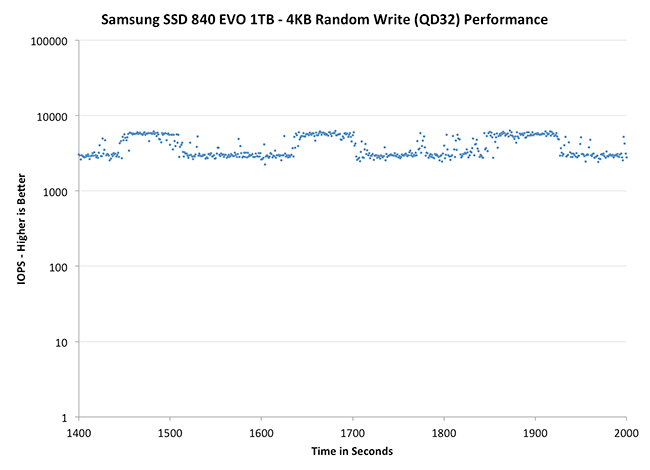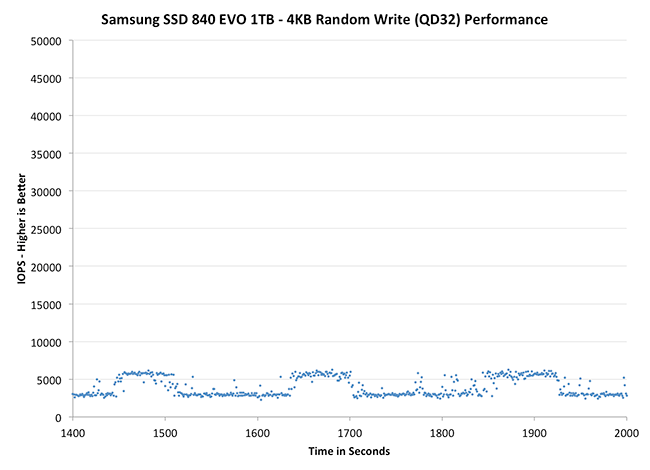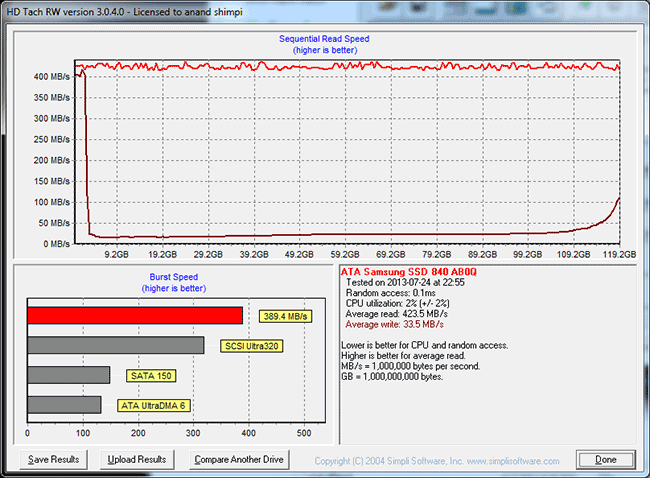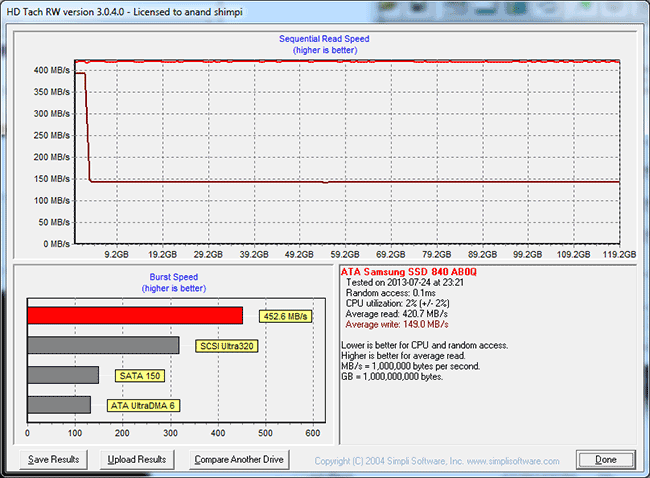Samsung SSD 840 EVO Review: 120GB, 250GB, 500GB, 750GB & 1TB Models Tested
by Anand Lal Shimpi on July 25, 2013 1:53 PM EST- Posted in
- Storage
- SSDs
- Samsung
- TLC
- Samsung SSD 840
Performance Consistency
In our Intel SSD DC S3700 review I introduced a new method of characterizing performance: looking at the latency of individual operations over time. The S3700 promised a level of performance consistency that was unmatched in the industry, and as a result needed some additional testing to show that. The reason we don't have consistent IO latency with SSDs is because inevitably all controllers have to do some amount of defragmentation or garbage collection in order to continue operating at high speeds. When and how an SSD decides to run its defrag and cleanup routines directly impacts the user experience. Frequent (borderline aggressive) cleanup generally results in more stable performance, while delaying that can result in higher peak performance at the expense of much lower worst case performance. The graphs below tell us a lot about the architecture of these SSDs and how they handle internal defragmentation.
To generate the data below I took a freshly secure erased SSD and filled it with sequential data. This ensures that all user accessible LBAs have data associated with them. Next I kicked off a 4KB random write workload across all LBAs at a queue depth of 32 using incompressible data. I ran the test for just over half an hour, no where near what we run our steady state tests for but enough to give me a good look at drive behavior once all spare area filled up.
I recorded instantaneous IOPS every second for the duration of the test. I then plotted IOPS vs. time and generated the scatter plots below. Each set of graphs features the same scale. The first two sets use a log scale for easy comparison, while the last set of graphs uses a linear scale that tops out at 40K IOPS for better visualization of differences between drives.
The high level testing methodology remains unchanged from our S3700 review. Unlike in previous reviews however, I did vary the percentage of the drive that I filled/tested depending on the amount of spare area I was trying to simulate. The buttons are labeled with the advertised user capacity had the SSD vendor decided to use that specific amount of spare area. If you want to replicate this on your own all you need to do is create a partition smaller than the total capacity of the drive and leave the remaining space unused to simulate a larger amount of spare area. The partitioning step isn't absolutely necessary in every case but it's an easy way to make sure you never exceed your allocated spare area. It's a good idea to do this from the start (e.g. secure erase, partition, then install Windows), but if you are working backwards you can always create the spare area partition, format it to TRIM it, then delete the partition. Finally, this method of creating spare area works on the drives we've tested here but not all controllers may behave the same way.
The first set of graphs shows the performance data over the entire 2000 second test period. In these charts you'll notice an early period of very high performance followed by a sharp dropoff. What you're seeing in that case is the drive allocating new blocks from its spare area, then eventually using up all free blocks and having to perform a read-modify-write for all subsequent writes (write amplification goes up, performance goes down).
The second set of graphs zooms in to the beginning of steady state operation for the drive (t=1400s). The third set also looks at the beginning of steady state operation but on a linear performance scale. Click the buttons below each graph to switch source data.
 |
|||||||||
| Crucial M500 960GB | Samsung SSD 840 EVO 1TB | Samsung SSD 840 EVO 250GB | SanDisk Extreme II 480GB | Samsung SSD 840 Pro 256GB | |||||
| Default | |||||||||
Thanks to the EVO's higher default over provisioning, you actually get better consistency out of the EVO than the 840 Pro out of the box. Granted you can get similar behavior out of the Pro if you simply don't use all of the drive. The big comparison is against Crucial's M500, where the EVO does a bit better. SanDisk's Extreme II however remains the better performer from an IO consistency perspective.
 |
|||||||||
| Crucial M500 960GB | Samsung SSD 840 EVO 1TB | Samsung SSD 840 EVO 250GB | SanDisk Extreme II 480GB | Samsung SSD 840 Pro 256GB | |||||
| Default | |||||||||
 |
|||||||||
| Crucial M500 960GB | Samsung SSD 840 EVO 1TB | Samsung SSD 840 EVO 250GB | SanDisk Extreme II 480GB | Samsung SSD 840 Pro 256GB | |||||
| Default | |||||||||
Zooming in we see very controlled and frequent GC patterns on the 1TB drive, something we don't see in the 840 Pro. The 250GB drive looks a bit more like a clustered random distribution of IOs, but minimum performance is still much better than on the standard OP 840 Pro.
TRIM Validation
Our performance consistency test actually replaces our traditional TRIM test in terms of looking at worst case scenario performance, but I wanted to confirm that TRIM was functioning properly on the EVO so I dusted off our old test for another go. The test procedure remains unchanged: fill the drive with sequential data, run a 4KB random write test (QD32, 100% LBA range) for a period of time (30 minutes in this case) and use HDTach to visualize the impact on write performance:
Minimum performance drops down to around 30MB/s, eugh. Although the EVO can be reasonably consistent, you'll still want to leave some free space on the drive to ensure that performance always stays high (I recommend 15 - 25% if possible).
A single TRIM pass (quick format under Windows 7) fully restores performance as expected:
The short period of time at 400MB/s is just TurboWrite doing its thing.












137 Comments
View All Comments
MVR - Thursday, November 14, 2013 - link
It will be very interesting when they start loading these up with more than 512MB of DRAM cache. Imagine a drive with 4-8+ GB on board. The response times would be insane. It is only a matter of time considering you can buy 8GB of SODIMM memory for $70. They could probably put it on board for $50 added cost to the drive - then these would truly act like PCIe SSD cards, except it would totally max out the SATA3 throughput limit.MVR - Thursday, November 14, 2013 - link
Of course SATA revision 3.2 at 16gbit/sec would sure enjoy it. Imagine a pair of those in RAID 0 :)Wao - Sunday, November 24, 2013 - link
I'm going to change my old noisy hard disk with a Samsung 840 EVO 1TB model. I am wondering if I really need to enable TRIM in OS X. I check the data sheet. It only said "Yes" about garbage collection and TRIM support. Does it meant that this model has its own garbage collection built-in, or I really need to enable TRIM in OS X. Honestly, I don't like to hack around the system files.Thanks !
iradel - Monday, November 25, 2013 - link
In the "IMFT vs. Samsung NAND Comparison" table, how did you get a Pages per Block value of 256 for 19nm TLC (a.k.a. the 840 EVO)? 8KB * 256 pages per block would imply an erase block size of 2048KB, whereas I've read that the 840 EVO has an EBS of 1536KB (which would mean 192 pages per block).Where did you get the 256 value?
sambrightman - Sunday, September 20, 2015 - link
I have the same question. I've read both the 840 and 840 EVO have 1536KiB EBS due to TLC, this is the only place saying 2MiB. Did you find an answer?Scraps - Tuesday, November 26, 2013 - link
What would be the optimum configuration for this situation. A MacBook Pro with 2 samsung evo 1tb. Would striped raid zero be the best ?code42 - Wednesday, December 18, 2013 - link
Can I use the Samsung 840 Pro 1TB with a NAS solution? Can some propose a nice setup? ThanksHal9009 - Wednesday, December 18, 2013 - link
Just received my new ASUS N550JV and updated the slow HD with 840 EVO-Series 750GB SSD, 16GB of G.SKILL 16GB (2 x 8G) 204-Pin DDR3 and a fresh copy of win-7x64...could not be happier, Samsung makes great SSDs7beauties - Saturday, December 28, 2013 - link
I bought the Samsung 840 EVO 1TB because Maximum PC gave it a 9 Kick *ss award, but they described it as being MLC. Good ole Anand tells it like it is. This is TLC. I was pretty steamed with Samsung because they describe this as their "new 3 bit MLC NAND," which I wouldn't have bought over Crucial's M500 960GB MLC SSD. Though Anand tries to calm fears of TLC's endurance, I can't understand what a "GiB" is and how I can calculate my drive's life span.verjic - Thursday, February 13, 2014 - link
I have a question. In some of the tests I found of real life use shows that Kingston V300 and Samsung a practically the same speed and even at copy 2 GB of 26000 files is slowly on samsung with about 30 %!!! Also installing a program like photoshop, takes longer on Samsung than Kingston, difference is not so big but is arou 10-15 %. Why is that? From all the test for kingston and Samsung, everyone say that Samsung is better but I don't see how? If anyone can explain to me, please